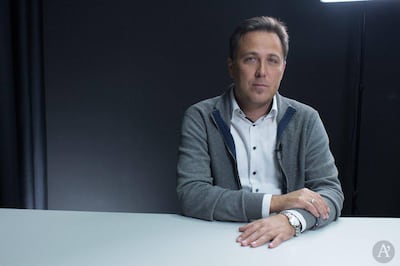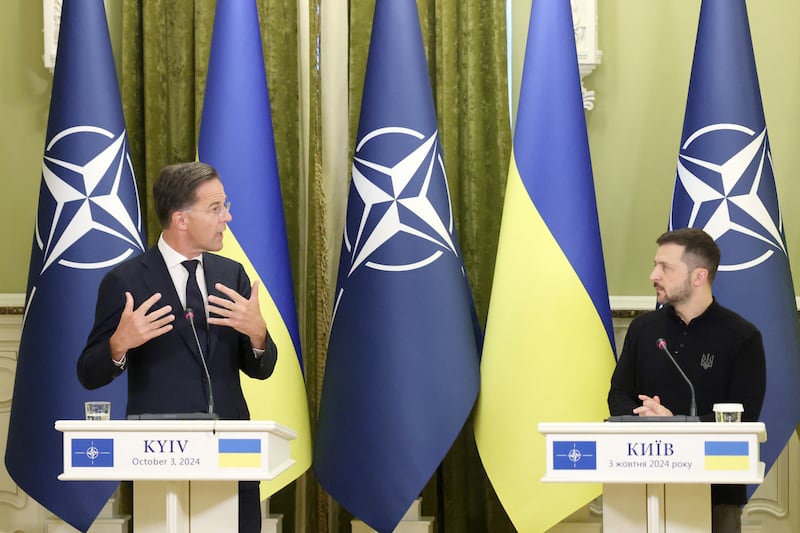On a golden autumn day in Kyiv this week, people strolling in the sun through the city centre may have found some brief respite from thoughts of war: the previous night had been relatively quiet, the dozen or so drones fired at Ukraine’s capital had all been intercepted, and no blackouts were scheduled as mild weather eased the strain on the country’s bomb-weakened power grid.
Then policemen stepped into the road and began clearing traffic, and a convoy of official cars swept into the square in front of the blue and gold St Michael’s monastery, where the long outer walls are now covered with photographs of men and women who have been killed defending Ukraine during a decade of Russian aggression.
Some passersby stopped to watch as Nato’s new secretary general, Mark Rutte, laid a wreath at the memorial during his first official trip in his new role – a visit that the former Dutch premier had said was intended “to make crystal clear to you, to the people of Ukraine, and to everyone watching, that Nato stands with Ukraine”.
After a while Rutte and his entourage drove away, traffic resumed and people drifted off about their business through the city. A few hours later, after nightfall, air defences boomed again around Kyiv to fend off a fresh swarm of Russian drones.
READ MORE
Ukrainians could be forgiven for feeling cynical about yet another visit by yet another western official. After all, at least one of them seems to visit each week, offering warm words and a wreath as the faces on the memorial wall multiply and Russia’s military occupies more of the eastern Donbas area – the town of Vuhledar fell this week – and blows more holes in Ukraine’s defences and critical infrastructure.
Warnings about what Ukraine faces in the months ahead now come as frequently as those dignitaries: energy experts warn of severe power shortages during the coldest and darkest months of the year, and the World Health Organisation fears they could trigger a crisis in the country’s damaged and overstretched hospitals.
At the front, Ukraine is still outnumbered and outgunned by a Russia that plans to increase its military budget by a quarter next year, ploughing 40 per cent of all government spending into its armed forces and security services.
Ukraine, meanwhile, is tending a shattered economy and reliant on western military aid that is still too little and arrives too slowly, and it is hostage to political fortune – Kyiv has no clear idea what approach the US will take to the war if Donald Trump wins re-election in November.
Ukrainian president Volodymyr Zelenskiy made a late attempt to secure bolder support from outgoing US counterpart Joe Biden on a visit to Washington last week, and is expected to make a last-ditch bid for the same at next weekend’s meeting in Ramstein, Germany, of leaders of dozens of countries that supply weapons to Ukraine.

“I know there is bipartisan support for Ukraine in the US and I don’t think it’s going to change though the elections,” says Oleksandra Ustinova, a Ukrainian deputy and vice-chairwoman of a parliamentary Ukraine-US friendship group, who was in Washington during Zelenskiy’s visit.
“People were telling me not to worry, that whoever comes to the [presidential] administration, you’ll get the same support as now – but we don’t need the same support: we need more,” she adds.
“We are outnumbered [by Russia] in terms of people and munitions and capabilities ... Our army can’t fight one on one against theirs – we need different, asymmetrical approaches – that’s why we keep going back to Washington to explain what our plans are, what our needs are and what restrictions need to be lifted for certain capabilities to be used.”
There has been no indication that Zelenskiy convinced Biden to let Ukraine strike military targets deeper inside Russia with western-made arms: US Atacms ballistic missiles, and Storm Shadow and Scalp cruise missiles provided by Britain and France respectively.
Kyiv says hitting Russia’s air bases and ammunition depots would disrupt its devastating daily air strikes on the battlefield and frontline towns and cities such as Kharkiv, Sumy and Zaporizhzhia using so-called Kab guided bombs, which contain up to three tonnes of explosives.
The Kremlin says such strikes by Ukraine would place Nato states at war with Russia, whose president, Vladimir Putin, lowered the country’s threshold for using nuclear weapons just as Biden prepared to meet Zelenskiy; the timing, Kyiv and several allies noted, showed that Putin wanted to feed the White House’s fear of “escalation”.
“Ukrainians have an allergy to this word,” says Ustinova. “Every type of weapon we have asked to use from day one of the war has been seen as ‘escalatory’: old MiG fighter jets, howitzers ... Himars [rocket systems] and air defence.
“Putin is always bullying everyone that there will be a bigger war, that he will use nukes. It’s strange for us, because now we control 1,000sq km of [Russia’s] Kursk region – it’s hard to imagine what could be more escalatory for him, but he does nothing anything about it.”
The morale boost for Ukraine from the operation in Kursk – where its troops still control a swathe of border towns and villages two months after invading – has been tempered by the simultaneous gains that Russia has made in Donbas, taking Vuhledar this week and bearing down on the small city and transport hub of Pokrovsk.
The fall of Pokrovsk would complicate Ukraine’s defence of the larger nearby cities of Slovyansk and Kramatorsk, and amplify doubts over the wisdom of attacking Kursk with soldiers who could have stiffened the line in Donbas.
Ukraine’s disadvantage in numbers and firepower force it to be innovative, and in recent months it has struck several military airfields and large ammunition depots hundreds of kilometres inside Russia with domestically made long-range drones.
Zelenskiy said this week that Ukraine produced 25 times more artillery and mortar ammunition in the first half of this year than during the whole of 2022, the first year of Russia’s full-scale invasion, and its defence industry could now make four million drones a year, more than 1.5 million of which have already been ordered.
[ Ukraine facing ‘decisive’ months in war as it seeks more US supportOpens in new window ]
At the same time, Zelenskiy said braver decisions by western powers were needed to force Russia to come to agree a just peace.
“The frontline must be strengthened, and long-range capabilities must finally be provided in the way necessary to end this war,” he said after meeting Rutte, noting that the US had shot down Iranian missiles over Israel without apparent fear of “escalation”.
“As we head into winter, Ukraine’s air defence is no less important, along with real progress in the joint interception of Russian missiles and drones ... What works in the skies of the Middle East and helps Israel’s defence can work just as well in the skies of our part of Europe,” Zelenskiy said.
He also reiterated to Rutte what he told Biden, about the need to provide the security guarantee of Nato membership for Ukraine alongside any agreement with Russia.
“Geopolitical certainty for Ukraine and for the whole of Europe is of the utmost value,” Zelenskiy said. “This is the solid foundation of peace.”
Ukrainian officials now talk less about fully defeating Russia on the battlefield than about establishing a position of strength from which to secure a fair settlement, and polls suggest the nation was becoming more open to the idea of talks with Moscow.
A survey published in August by the Kyiv International Institute of Sociology (KIIS) found that 57 per cent of people think Ukraine should engage in peace negotiations, marking a return to a level not seen since the first, shocking months of the full-scale war in 2022; at the same time, however, well over 70 per cent said they would not accept Russia’s permanent occupation of land it now holds, or trade Ukraine’s EU and Nato membership hopes for peace.
A KIIS poll in May found that 32 per cent of people would accept some form of territorial concessions in exchange for peace, compared with 10 per cent a year earlier – but 55 per cent remained categorically opposed to surrendering any land to Russia.

“People are much less optimistic than a year or two ago. Now they are much more realistic and understand that this war will last for quite a long time,” says Mykola Kapitonenko, an associate professor at the institute of international relations of Kyiv National Taras Shevchenko University.
“But change in the public mood will not have a decisive effect on the development of the war, because Ukrainians may be getting used to the idea of having to pay a heavier price for the war – including blackouts, mobilisation and a general decrease in wellbeing in every sense of word. They seem to be prepared for that, so it doesn’t convert automatically into a desire to end the war at all costs.”
Time and maths are against Ukraine, however: the attention and commitment of the West will surely wane as the war grinds on, and other crises – such as the one in the Middle East – will take precedence; and Kyiv’s mobilisation drive has been slow and divisive, as it struggles to replenish its weary and vastly outnumbered ranks with troops possessing the skills and motivation needed for the fight.
The West is “actually prolonging the war” by giving Russia enough leeway to believe that it will always be able to keep fighting in Ukraine, evading sanctions and conducting trade and diplomacy around the world, until it eventually wins, says Orysia Lutsevych, deputy director of the Russia and Eurasia programme at Chatham House.
“We are in very dangerous territory where people are, I think, a bit infantile about what is at stake. I’m nervous that [western leaders] are not even thinking about the mid-term implications of what this means,” says Lutsevych, who is also head of the British think tank’s Ukraine Forum.
She believes the war has emboldened autocracies and other competitors of the West, and they would interpret Ukraine’s defeat as a victory for Russian authoritarianism over the US and its allies.
“Of course, Ukrainians are tired of war and want it to end and to see light at the end of the tunnel, which is very hard now. But they are also very realistic in understanding the nature of Russia,” she says. “I think this is where you see a big gap between the understanding of Russia in Ukraine and, for example, in Berlin.
“It’s hard for people to imagine Russia’s behaviour in occupied territory or understand what the Russian military actually is. If Ukraine will be left in limbo, then I think we will all be worse off,” she adds.
It would be extremely hard for Zelenskiy to convince Ukraine’s military to trade territory for peace “because they have been fighting so hard for every inch of Ukrainian land”, and equally difficult to persuade society at large to accept any deal that did not come alongside Nato membership or other “iron-clad” security guarantees for the country, says Lutsevych.
“If Ukrainians would feel that a deal has been imposed on Ukraine simply because the West is ‘tired’ for some reason – while not having to fight – or wants to go back to business as usual with Russia, then it will cause huge anti-western sentiment. Ukraine will feel betrayed. You can feel that, talking to people.”

A survey by pollsters Chronicles and ExtremeScan in Russia last month showed that 49 per cent of people there would support a decision by Putin to withdraw troops from Ukraine and start ceasefire negotiations without achieving his war aims, and 63 per cent would like to establish peace within a year.
Yet Putin insists that no talks are possible until Ukraine accepts Russia’s permanent occupation of five regions and abandons its hopes of Nato membership.
“People are tired, but we understand that we have no choice,” says Ustinova of Ukrainians’ readiness to fight on against Putin’s invasion force. “And we understand that he’s not going to stop.”
- Sign up for push alerts and have the best news, analysis and comment delivered directly to your phone
- Join The Irish Times on WhatsApp and stay up to date
- Listen to our Inside Politics podcast for the best political chat and analysis





















